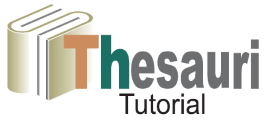Standards provide a framework of agreement and rule-setting, and are used as tools to facilitate usability, compatibility, mutual understanding, integration, interoperability etc.
Standardization contributes to:
- identifying the appropriate concepts and terms that will be used to create a particular thesauri or other equivalent system
- the ability to encode and record the data in a uniform way
- the ability to interconnect, match, combine and exchange data
- the ability to access, search, present and evaluate the data of a system or associated knowledge organization systems
- to formulate rules and guidelines for the proper implementation of the above.
Thesauri Standards
There are many national and international standards that provide guidelines for thesauri building. Below there is a list of the most widely used thesauri standards in chronological order.
- DIN 1463 Guidelines for the establishment and development of monolingual thesauri. 1972 (followed by later editions)
- ISO 2788 ‘Guidelines for the Establishment and Development of Monolingual Thesauri was published in 1974. It was revised in 1986 when it introduced the concept of systematic thesaurus, facet analysis and more precise rules on the handling of compound terms (superseded by ISO 25964).
- ISO 5964 ‘Documentation - Guidelines for the establishment and development of multilingual thesauri’ was released for in 1985 (superseded by ISO 25964).
- ANSI/NISO Z39.19 Guidelines for the construction, format, and management of monolingual thesauri. 1993 (revised 2005 and renamed Guidelines for the construction, format, and management of monolingual controlled vocabularies.). It gives advice on how to formulate prefered terms, the relationships that should be shown between the terms and the way terms and relationships should be displayed. It was further revised in 2010)
- BS 8723-1:2005, BS 8723-2:2005, BS 8723-3:2007, BS 8723-4:2007: Structured Vocabularies for Information Retrieval. The first two parts include principles of thesaurus construction, including facet analysis, presentation in electronic and printed media, thesaurus functions in electronic systems, and requirements for thesaurus management software. The last two cover vocabularies other than thesauri and interoperability between vocabularies.
- ISO 25964 ‘Thesauri and interoperability with other vocabulary’, which covers all types of thesauri uniformly, 2013. It is divided into two parts:
- the first part, which has replaced ISO 2788 and ISO 5964, deals with issues of thesauri development and maintenance, such as concepts and terms of thesauri, relationships between concepts and terms, presentation, management and software for their construction. It includes a data model and an XML schema for the import and export of thesaurus data.
- the second part of the standard addresses interoperability and mapping issues between different thesauri or between thesauri and other thematic vocabularies.





